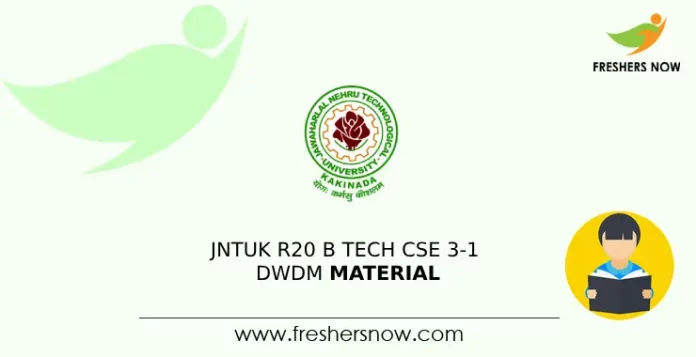
JNTUK R20 B Tech CSE 3-1 DWDM Material/ Notes PDF Download: Looking for study JNTUK R20 B Tech CSE 3-1 DWDM Material. You’re in the right place! Our collection includes everything you need, from notes to PDF downloads, tailored for CSE students like you. Learn the basics of data warehousing and data mining, and understand how to preprocess different types of data effectively. Discover interesting patterns, analyze various models, and accurately assess algorithm accuracy. With our comprehensive materials, you’ll be well-equipped to excel in your DWDM studies. Start your learning journey today!
JNTUK R20 B Tech CSE 3-1 DWDM Material – Units
| No. Of Units | Name of the Unit |
| Unit – 1 | Data Warehousing and Online Analytical Processing |
| Unit – 2 | Data Pre-processing |
| Unit – 3 | Classification |
| Unit – 4 | Association Analysis |
| Unit – 5 | Cluster Analysis |
Unit 1 Syllabus PDF Download | JNTUK R20 B Tech CSE Data Warehousing and Data Mining Material
Data Warehousing and Online Analytical Processing: Data Warehouse: Basic concepts, Data Warehouse Modelling: Data Cube and OLAP, Data Warehouse Design and Usage, Data Warehouse Implementation, Introduction: Why and What is data mining, What kinds of data need to be mined and patterns can be mined, Which technologies are used, Which kinds of applications are targeted.
| JNTUK R20 B Tech CSE 3-1 DWDM Material – PDF Download | |
| To Download The JNTUK R20 B Tech CSE 3-1 DWDM Unit 1 Notes PDF | Download PDF |
Unit 2 Syllabus PDF Download | JNTUK R20 B Tech CSE Data Warehousing and Data Mining Material
Data Pre-processing: An Overview, Data Cleaning, Data Integration, Data Reduction, Data Transformation and Data Discretization.
| JNTUK R20 B Tech CSE 3-1 DWDM Material – PDF Download | |
| To Download The JNTUK R20 B Tech CSE 3-1 DWDM Unit 2 Notes PDF | Download PDF |
Unit 3 Syllabus PDF Download | JNTUK R20 B Tech CSE Data Warehousing and Data Mining Material
Classification: Basic Concepts, General Approach to solving a classification problem, Decision Tree Induction: Attribute Selection Measures, Tree Pruning, Scalability and Decision Tree Induction, Visual Mining for Decision Tree Induction.
| JNTUK R20 B Tech CSE 3-1 DWDM Material – PDF Download | |
| To Download The JNTUK R20 B Tech CSE 3-1 DWDM Unit 3 Notes PDF | Download PDF |
Unit 4 Syllabus PDF Download | JNTUK R20 B Tech CSE Data Warehousing and Data Mining Material
Association Analysis: Problem Definition, Frequent Item set Generation, Rule Generation: Confident Based Pruning, Rule Generation in Apriori Algorithm, Compact Representation of frequent item sets, FPGrowth Algorithm.
| JNTUK R20 B Tech CSE 3-1 DWDM Material – PDF Download | |
| To Download The JNTUK R20 B Tech CSE 3-1 DWDM Unit 4 Notes PDF | Download PDF |
Unit 5 Syllabus PDF Download | JNTUK R20 B Tech CSE Data Warehousing and Data Mining Material
Cluster Analysis: Overview, Basics, and Importance of Cluster Analysis, Clustering Techniques, Different Types of Clusters; K-means: The Basic K-means Algorithm, K-means Additional Issues, Bi-secting K Means.
| JNTUK R20 B Tech CSE 3-1 DWDM Material – PDF Download | |
| To Download The JNTUK R20 B Tech CSE 3-1 DWDM Unit 5 Notes PDF | Download PDF |
JNTUK R20 B Tech DWDM Material Outcomes
- Data Warehousing and Data Mining are crucial for businesses to efficiently manage and extract insights from large datasets, aiding in decision-making and gaining a competitive edge.
- Data Preprocessing Techniques such as data cleaning, integration, transformation, and reduction are essential steps to prepare raw data for analysis, ensuring its quality and relevance for various data mining algorithms.
- Selecting the appropriate classification technique is vital for organizing and categorizing data into predefined classes, enabling accurate prediction, model building, and evaluation of outcomes.
- Association rule mining techniques like Apriori and FP Growth algorithms are valuable for uncovering meaningful patterns and relationships within datasets, particularly in the generation of frequent item sets that provide valuable insights for business strategies.
- Applying various clustering algorithms using open-source tools allows organizations to identify natural groupings within data, interpret the results, evaluate their effectiveness, and generate reports to support decision-making processes efficiently.
For more details about JNTUK R20 B Tech CSE 3-1 DWDM Material and other materials follow our official website Freshersnow.com.



